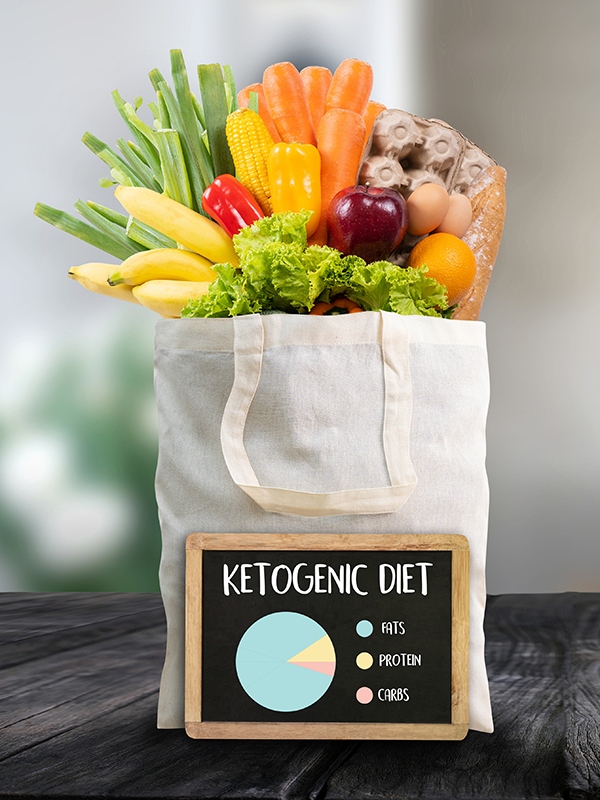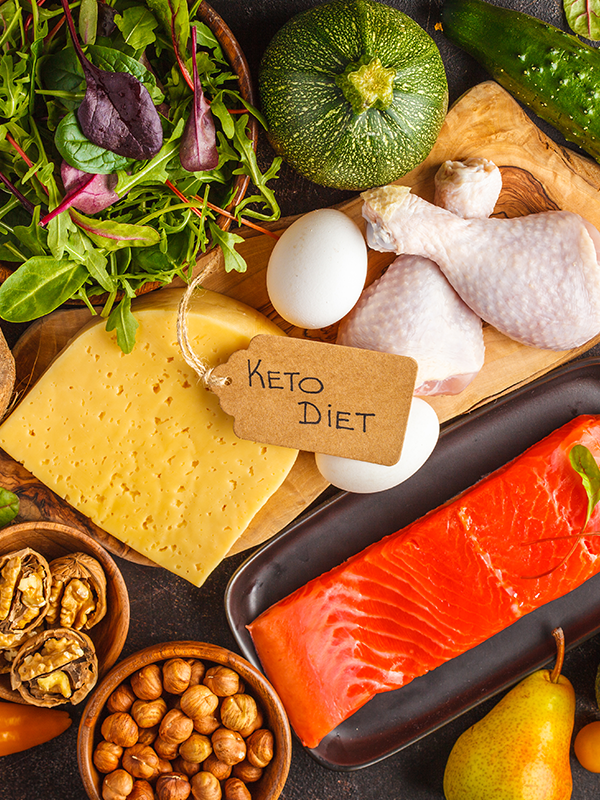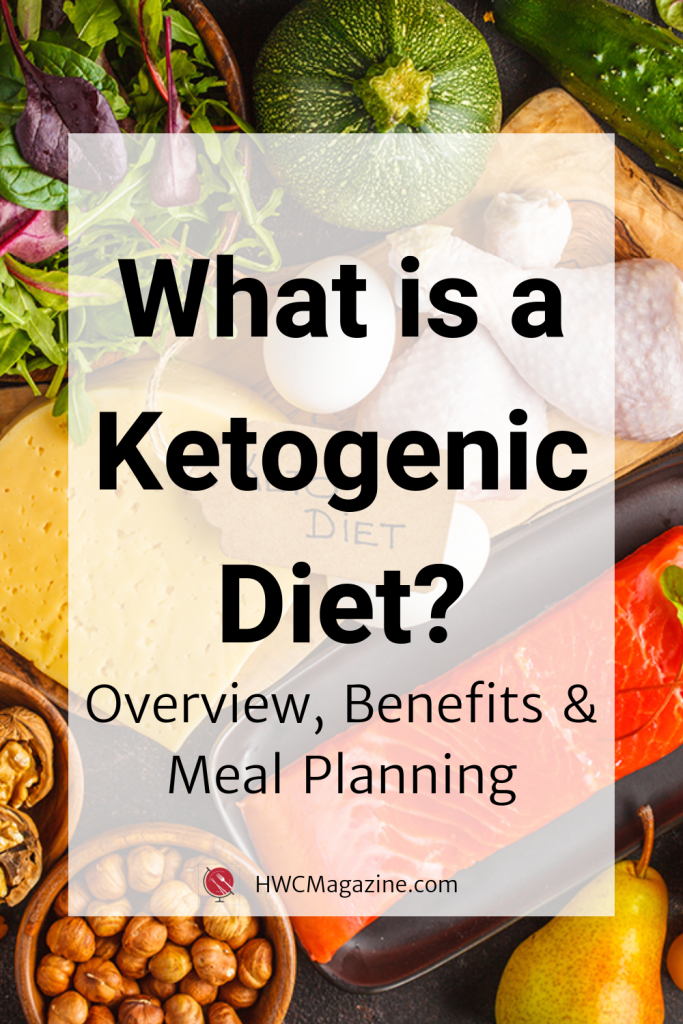Author: Sophia Norton - Dietary Expert at Kiss My Keto
Have you wondered what exactly is a ketogenic diet? In this article, we are going to cover how a keto diet works, health benefits, how to prepare, and easy meal plans for you to try this week.
The ketogenic diet (aka the keto diet) is one of the most popular eating plans to emerge in the past couple of years. Defined as a high-fat, low-carb diet, keto definitely goes against the grain and traditional wisdom of what constitutes healthy eating.
But despite appearing counterintuitive, the diet is heavily backed by research. Researcher have found evidence that the diet is an effective tool for achieving better health and a slimmer waistline.
Jump to:
What is it?
The ketogenic diet is defined as a very-low-carbohydrate, moderate-protein, and high-fat diet. The term "ketogenic" means “to generate ketones” – acidic molecules that replace glucose as fuel. When your body is making ketones on a keto diet, it is in a metabolic state called nutritional ketosis – the main goal of the ketogenic diet.

Macronutrient ratio
- 5-10% calories from carbs
- 20-25% calories from protein
- 65-75% calories from fat
This macronutrient ratio creates somewhat of an energy crisis – carb intake is too low to provide enough glucose to the brain. The body adjusts to this energy crisis by producing ketones, which now replace glucose as fuel. But to make ketones, the body needs to burn fat. It burns fat from the food you eat. It can also burn its own fat stores providing you're also restricting calories.
How it All Began
The keto diet was originally designed in the 1920s to treat childhood epilepsy. The idea was to make a diet that mimics the metabolic effects of prolonged fasting. Fasting also increases ketone levels, but it cannot be followed indefinitely.
The keto diet proved to be a feasible alternative to fasting and that has helped thousands of children with epilepsy. Research carried out in decades to follow discovered the countless other potentials and benefits of this diet (more on that later).

What Keto Looks Like
It can be hard to imagine what a diet that consists mostly of fat should look like. Does that mean eating globs of butter and bacon with every meal? Well, not really. Take a look at our Asian Keto Recipes for Chinese Thanksgiving as an example.
The keto diet consists of a number of foods you can eat and a whole list of foods you need to exclude. It also relies on keto-friendly substitutes for carb-rich ingredients to help you make delicious meals you can actually enjoy.
Foods Allowed
- Fatty cuts of meat like minced beef and ribeye steak
- Fatty fish like sardines and salmon
- Full-fat dairy, especially butter
- Nuts and seeds
- Avocados
- Low-carb vegetables and berries
- Nut milks, nut butters, and nut flours
- Herbs and spices
- Sugar-free condiments
Foods Forbidden
- All cereal grains as well as pseudo-cereals
- Legumes such as beans, chickpeas, lentils, and soy
- Starchy vegetables and most fruit
- High-carb vegetables
- Sweeteners like sugar, honey, and corn syrup
- Dairy milk and soy milk
Since the keto diet excludes many dietary staples, keto dieters need to be creative with meal preparation. Luckily, there are plenty of free and affordable resources online to help you learn how to prepare keto-friendly food.

Health Benefits?
Since the keto diet was first developed back in 1921, countless studies on the health benefits of this diet have been carried out. So far, there's strong evidence that the diet can provide these benefits:
Epilepsy
A keto diet can reduce seizure frequency to 40%, and it is as effective as some anti-epileptic medication. The diet is still used in cases of drug-resistant epilepsy and with great efficiency. Nobody knows how keto really works to help reduce seizures, but the main theory is that ketones improve the way brain uses energy.
Weight loss
The keto diet can help people lose weight quickly. The diet mainly works by up-regulating fat burning. However, keto also suppressing appetite by lowering insulin and through the direct hunger-suppressing effect of ketones. The diet may also contribute to weight loss because maintaining ketosis is an energy-costly process.
Type 2 diabetes control
Diabetes is a disease of glucose metabolism, so it makes sense to use a low-carbohydrate diet to treat this metabolic disorder. By reducing carbs, type 2 diabetes patients see an improvement in their blood glucose and insulin levels. Studies even show that the diet helps patients rely less on medication.
Cardiovascular disease prevention
Normally, we associate high-fat diets with a greater risk of heart attacks and stroke. But the keto diet has a uniquely beneficial effect on the cardiovascular system despite being high in fat. The diet leads to weight loss and improved blood glucose levels, which is good for your heart and arteries. It also lowers triglycerides and total cholesterol while increasing HDL cholesterol and LDL particle size.
There's also evidence the ketogenic diet can be helpful with acne, Alzheimer's, Parkinson's, polycystic ovary syndrome (PCOS), brain trauma, psychiatric disorders, and even cancer. However, research in these areas is still new.

How to Start Keto
Before you consider starting the keto diet, it's a good idea to learn about this diet as much as possible. This will help you understand what you need to focus on to make the diet work for you. It will also prevent dieting mishaps.
With that said, here are some steps you need to take to start a keto lifestyle:
Stock up on keto food
Buy keto-friendly foods mentioned earlier in this article and avoid foods not allowed on a keto diet. Having keto food available at all times will help you stick to this way of eating and keep you from cheating on your diet.
Make a plan
Making a weekly or monthly meal plan that includes a keto shopping list and recipe ideas will also help you stay on track. The keto diet involves lots of planning and meal preparation – you simply can't leave anything to chance on this die, unless you're experienced, that is.
Track your keto macros
Diet apps like MyFitnessPal and Carb Manager can help you track your keto macros. The term “keto macros” refers to the macronutrient ratio of the keto diet mentioned at the beginning of this article. In other words, keto macros are the grams of carbs, protein, and fat you need to eat on a keto diet to get into and stay in ketosis. You can also track your macros with the help of food databases like SELF Nutrition Data.
Prepare for the keto flu
The keto flu is a common way of referring to side effects of carbohydrate withdrawal. These flu-like symptoms happen as a result of glycogen depletion, which happens within the first week of the keto diet. When people lose glycogen, they also tend to lose a lot of water through frequent urination. To prevent the keto flu, it is recommended to increase your electrolyte and fluid intake in the first week of starting keto.
Check for ketosis
Since ketosis is the primary goal of keto, it is important to know whether the diet you're eating has helped you reach this state. You can check for ketosis by using ketone test strips or looking for ketosis signs and symptoms like a fruity breath, increased energy, and weight loss.
Takeaways
While the keto diet may seem unusual at first, there's plenty of evidence that this low-carb, high-fat eating plan comes with a plethora of health benefits. From boosting weight loss to possibly preventing chronic diseases, there's a lot to be gained from starting a low-carb lifestyle. However, for this diet to work, it is important to learn as much about this diet and its effects on the body as possible.
Keto Meal Ideas
Did You Like Our Recipe? Leave a ⭐⭐⭐⭐⭐ rating and/or a review in the comments section below. Your feedback is always appreciated! Follow us for more delicious recipes on Pinterest, Instagram, Twitter and Facebook! Don't forget to sign up for our email list for more free recipes.

About the Author:
Sophia Norton is a Dietary Expert at Kiss My Keto. She is a driven, dedicated and team-oriented professional with more than 6 years of experience providing wellness and nutritional support in various capacities. After Sofia learned about "food deserts" as a kid, she became determined to devote her life to like making healthy foods accessible to everyone, regardless of income or location. Sofia has traveled around the world, teaching nutrition to communities in extreme poverty. In her spare time, Sofia loves long bike rides and exploring local farmer's markets.
Please Note: A keto diet is a medical diet and/or a therapeutic diet. The keto diet can be very helpful for some individuals. However, each person is different and has different medical needs. The keto diet may not appropriate for some individuals with different medical conditions. Please discuss any diet changes with your physician BEFORE starting a new diet plan.
Disclaimer: The contents of this website are for informational purposes only and do not constitute medical advice. The Content is not intended to be a substitute for professional medical advice, diagnosis, or treatment. Always seek the advice of a physician or other qualified health provider with any questions you may have regarding a medical condition. Never disregard professional medical advice or delay in seeking it because of something you have read on this website.
In the event of a medical emergency, call a doctor or 911 immediately. This website does not recommend or endorse any specific tests, physicians, products, procedures, opinions, or other information that may be mentioned on the Site. Reliance on any information provided by this website is solely at your own risk.













Heidi | The Frugal Girls says
Thank you for these fantastic tips! I've definitely been eating less carbs lately, and these tips will be SO helpful!!
HWC Magazine says
Thank you Heidi. A ketogenic diet is not for everyone but if you have a health condition that warrants that you need to get that weight off - these tips can guide you. Most of us eat so many more refined sugars and carbs than we really should so cutting back on those is always a good thing. Take Care